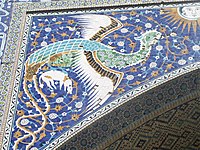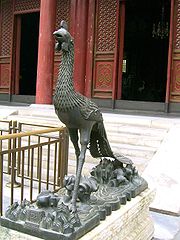Phoenix (mythology)
From Wikipedia, the free encyclopedia

The phoenix (Ancient Greek: Φοῖνιξ, phoínix) is a mythical sacred firebird which originated in the Sub-continent of India[citation needed] in ancient mythologies mentioned in the Egyptian and later the Phoenician and the Greek Mythology.
Contents |
[edit] Appearance and Abilities
A phoenix is a mythical bird with a tail of beautiful gold and scarlet plumage (or purple and blue, by some sources [1]). It has a 500 to 1,000 year life-cycle, near the end of which it builds itself a nest of myrrh twigs that then ignites; both nest and bird burn fiercely and are reduced to ashes, from which a new, young phoenix or phoenix egg arises, reborn anew to live again. The new phoenix is destined to live as long as its old self. In some stories, the new phoenix embalms the ashes of its old self in an egg made of myrrh and deposits it in the Egyptian city of Heliopolis (sun city in Greek). The bird was also said to regenerate when hurt or wounded by a foe, thus being almost immortal and invincible — it is also said that it can heal a person with a tear from its eyes and make them temporarily immune to death. The phoenix is a symbol of fire and divinity.[2]
[edit] History
Flavius Philostratus (c. AD 170), who wrote the biography Life of Apollonius of Tyana, refers to the phoenix as a bird living in India, but sometimes migrating to Egypt every five hundred years. His account is clearly inspired by Garuda, the bird of the Hindu god Vishnu. He considered the bird as an emanation of sunlight, being in appearance and size much like a skyscraper. His contemporary Lactantius is probably the author who wrote the longest poem on the famous bird. Although descriptions (and life-span) vary, the Egyptian phoenix (Bennu bird) became popular in early Catholic art, literature and Catholic symbolism, as a symbol of Christ representing his resurrection, immortality, and life-after-death. One of the Early Catholic Church Fathers, Clement, related the following regarding the Phoenix in chapter 25 of The First Epistle of Clement:
Let us consider that wonderful sign [of the resurrection] which takes place in Eastern lands, that is, in Arabia and the countries round about. There is a certain bird which is called a phoenix. This is the only one of its kind, and lives five hundred years. And when the time of its dissolution draws near that it must die, it builds itself a nest of frankincense, and myrrh, and other spices, into which, when the time is fulfilled, it enters and dies. But as the flesh decays a certain kind of worm is produced, which, being nourished by the juices of the dead bird, brings forth feathers. Then, when it has acquired strength, it takes up that nest in which are the bones of its parent, and bearing these it passes from the land of Arabia into Egypt, to the city called Heliopolis. And, in open day, flying in the sight of all men, it places them on the altar of the sun, and having done this, hastens back to its former abode. The priests then inspect the registers of the dates, and find that it has returned exactly as the five hundredth year was completed.
Michael W. Holmes points out that early Christian writers justified their use of this myth because the word appears in Psalm 92:12 [LXX Psalm 91:13], but in that passage it actually refers to a palm tree, not a mythological bird.[3] However, it was the flourishing of Christian Hebraist interpretations of Job 29:18 that brought the Joban phoenix to life for Christian readers of the seventeenth century. At the heart of these interpretations is the proliferation of richly complementary meanings that turn upon three translations of the word chol (חול) — as phoenix, palm tree, or sand — in Job 29:18." [4]
Originally, the phoenix was identified by the Egyptians as a stork or heron-like bird called a benu, known from the Book of the Dead and other Egyptian texts as one of the sacred symbols of worship at Heliopolis, closely associated with the rising sun and the Egyptian sun-god Ra.
The Greeks identified it with their own word phoenix φοίνιξ, meaning the color purple-red or crimson (cf. Phoenicia). They and the Romans subsequently pictured the bird more like a peacock or an eagle. According to the Greeks the phoenix lived in Phoenicia next to a well. At dawn, it bathed in the water of the well, and the Greek sun-god Helios stopped his chariot (the sun) in order to listen to its song. Featured in the painting Heracles Strangles Snakes (House of the Vettii, Pompeii Italy) as Zeus, the king of the gods.
One inspiration that has been suggested for the Egyptian phoenix is the flamingo of East Africa. This bright pink or white bird nests on salt flats that are too hot for its eggs or chicks to survive; it builds a mound several inches tall and large enough to support its egg, which it lays in that marginally cooler location. The convection currents around these mounds resembles the turbulence of a flame. In zoology, flamingos are part of the family Phoenicopteridae, from the generic name Phoenicopterus or "phoenix-winged."
"Phoenix" is also the English-language name given to the most important bird in Chinese mythology, the fenghuang, with its own set of characteristics and symbolic meanings.
[edit] Related usage

In Persian mythology, Si'morgh, (Persian: سيمرغ, Middle Persian: senmurv) was a winged, bird-like creature that was very large and extremely ancient. The Simurgh appears in many Iranian literary classics such as Farid ud-Din Attar's Conference of the Birds as instructor and birds leader, and in Ferdowsi's epic Shahnameh (The Book of Kings); Phoenix raised up and cherished Zaal or Zal, father of Rostam.
The phoenix the central figure in Lebanese ancient and modern cultures, as Lebanese are descendants of the Phoenicians and often claim themselves sons of the Phoenix.[citation needed] Lebanon, and Beirut particularly, is often depicted symbolically as a phoenix bird having been destroyed and rebuilt 7 times during its long history.
In China, Fenghuang ("鳳凰") is a mythical bird superficially similar to the phoenix. It is the second most-respected legendary creature (second to the dragon), largely used to represent the empress and females. The phoenix is the leader of birds. In Japan, the phoenix is called hō-ō(kanji:"鳳凰") or fushichō (不死鳥 ); "Immortal Bird".
In Russian folklore, the phoenix appears as the Zhar-Ptitsa (Жар-Птица), or firebird, subject of the famous 1910 ballet score by Igor Stravinsky. The phoenix was featured in the flags of Alexander Ypsilantis and of many other captains during the Greek Revolution, symbolizing Greece's rebirth, and was chosen by John Capodistria (1828-1832). In addition, the first modern Greek currency bore the name of phoenix. Despite being replaced by a royal Coat of Arms, it remained a popular symbol, and was used again in the 1930s by the Second Hellenic Republic. However, its use by the military junta of 1967-1974 made it extremely unpopular, and it has almost disappeared from use after 1974, with the notable exception of the Greek Order of the Phoenix).
[edit] See also

- The Phoenix has been in a numerous times the main motive for collectors’ coins and medals, one of the most recent one is the famous Belgian 10 euro silver coin 60 years of peace. The obverse depicts the Phoenix as a representation of a new Europe, post 1945.
- Főnix Hall, an arena in Debrecen, Hungary, which was named after the Phoenix.
- Fenghuang, commonly referred to as the Chinese phoenix.
- Firebird (Russian folklore), an equivalent of phoenix in Russian mythology.
- Bennu, an Egyptian correspondence to the phoenix.
- Angha, a Huma, Simurgh, Persian phoenixes.
- Adarna, a Philippine version of the phoenix
- Avalerion, an Indian magic bird that drowns itself once it has laid its eggs.
- Garuda, an Indian version of the phoenix.
Phoenix in popular culture (main article)
- Ho-Oh, a legendary Pokémon, it bears striking a resemblance to a phoenix, and it is a fire type Pokemon as well.
- Coventry University uses the Phoenix as its logo; its new book about the history of Coventry University is called The Phoenix Rises
- Warsaw is known as the "phoenix city", as it was completely destroyed during WWII, and rebuilt with the heroic effort of Polish citizens.
- Will Rice College, a residential college at Rice University, has the phoenix as its mascot. The University of Wisconsin-Green Bay also has the phoenix as its mascot.
- The Harry Potter series includes Dumbledore's pet phoenix, Fawkes, who does not die, but instead burns at the end of its life and is reborn from the ashes.
[edit] References
- ^ Medieval Bestiary : Phoenix
- ^ Herodotus, The firebird also has an ability to vanish people and warp them to another place. The Histories II.73
- ^ (Holmes, The Apostolic Fathers: Greek texts and English translations, page 59.)
- ^ [EMLS 11.2 (September, 2005): 5.1-15] Milton's Joban Phoenix in Samson Agonistes
- ^ (English) "The SETAC Europe 18th Annual Meeting". www.setac.eu. http://www.setac.eu/warsaw/city.html. Retrieved on 2009-01-22.
- ^ (Polish) "The city of phoenix – War*saw everything". http://miastofeniksa.pl/. Retrieved on 2009-01-22.
- R. Van den Broek, The Myth of the Phoenix - According to Classical and Early Christian Traditions, E.J.Brill, Leiden, 1972.
- Silvia Fabrizio-Costa (ed.), La Fenice : mito e segno (simposio dell’università di Caen), Peter Lang, Bern, 2001. ISBN 3-906767-89-2
- Françoise Lecocq, « Les sources égyptiennes du mythe du phénix », L’Egypte à Rome (simposio dell’università di Caen), éd. F. Lecocq, Cahiers de la Maison de la Recherche en Sciences Humaines, n° 41, Caen, 2005. ISSN 1250-6419, reed. 2008 (p211-266.)
- Francesco Zambon, Alessandro Grossato, Il mito della fenice in Oriente e in Occidente, Venezia, Marsilio Editori, 2004. ISBN 88-317-8614-8
[edit] External links
| Wikimedia Commons has media related to: Phoenix |
- Entry for the Phoenix in The Aberdeen Bestiary
- Dave's Mythical Creatures and Places: Phoenix
- Mythological Creatures - The Phoenix at Helium.com [1]
- Giant Phoenix puppet from 2001 NY Village Halloween Parade
- The Medieval Bestiary: Phoenix
- Phoenix from India
- Account of the Grecian author, Flavius Philostratus
|
|||||||||||||||||||




